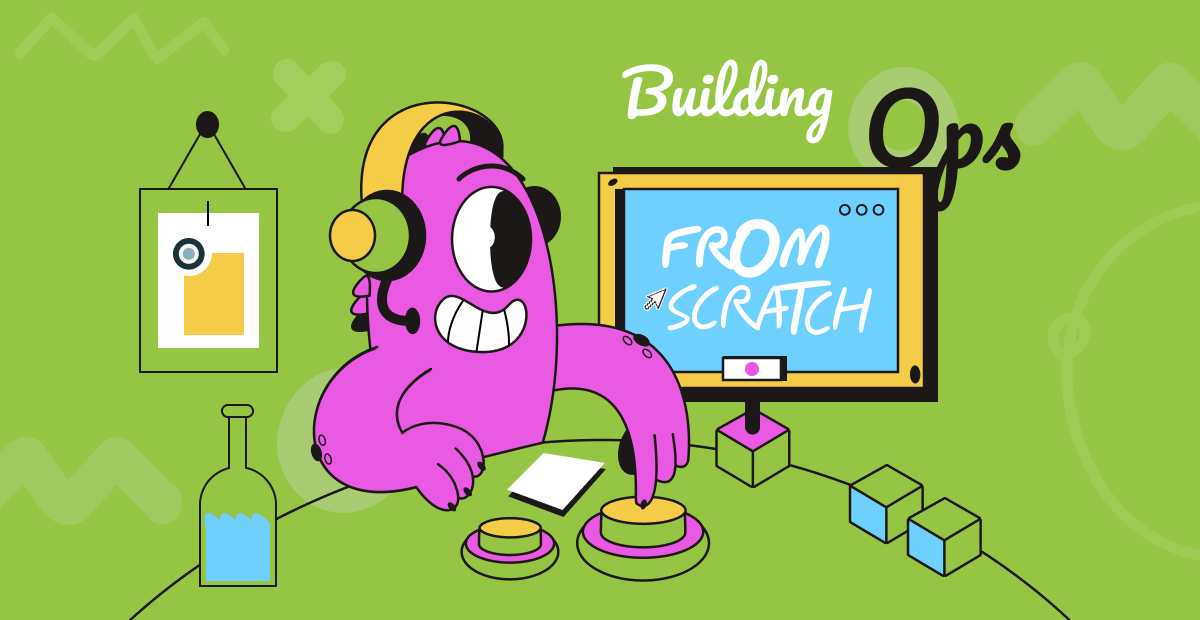Why Research Ops matters
Research Ops is key to driving the maturity of a research function and product org, whether you’re at a startup laying the first foundations for a small panel or part of an enterprise team recruiting thousands of B2B participants each year.
Aaron Fulmer, former Research Ops Manager at Microsoft, who led teams like Customer Insights Research for over a decade, recalls his early days in 2010, when the UXR team ran ~ 300 studies annually with 12,000 participants:
As operations scaled...researchers needed to focus more on customer needs, partners, and research design. For the rest, we needed Research Ops.Microsoft’s UXR team multitasked like pros, but operational pressures—still relevant to modern research teams—such as recruiting participants, tech stack breakdowns, and lack of centralized guidelines kept projects off track.
To optimize testing rhythms, Fulmer and his team streamlined internal processes, building a research operations framework around these three core challenge components. That way, when a research partner needed a study, Research Ops handled the logistics, freeing researchers to focus on designing and conducting meaningful work. Since 2010, this foundation has enabled the team to move upstream—curating insights, managing budgets, and shaping research priorities—creating impact that extends well beyond day-to-day operations.
This is effective Research Ops: the systems, processes, and tools that help research teams work efficiently and with impact. It fuels collaboration and guides human-centered design and product decisions.
This guide lays out operational tasks, tools, and strategies to scale efficiently.In this piece, you’ll hear from top teams who built their Ops practice from the ground up—setting up participant-management systems, choosing user-research CRMs and tools, and shaping Ops into a strategic partner that amplifies their team’s impact.
What Is Research Ops
In UX and product development, Research Ops is the discipline that keeps user research running at full speed. It oversees the systems, tools, and workflows that make studies efficient and scalable—from recruiting participants and managing data to choosing the right platforms and maintaining governance.
Whether you’re at lean startup or a global enterprise, if the goal is to help research, product and design teams recruit, test, and incentivize at scale, by cutting friction from the research process, Research Ops turns insights into action, powering smarter product decisions, stronger user satisfaction, and steady business growth. At its core, it’s the backbone of a company’s research function, making sure insights are gathered, analyzed, and applied.
How ReOps Supports researchers, designers, and product teams
Andrea Lewis has led UX research projects of all sizes—from small pilots to global initiatives—across a range of industries. She has been hands-on in user experience design since the discipline’s early days, giving her a rare perspective on how Research Operations frameworks help researchers, designers, and product teams stay aligned and deliver actionable insights. Her dual expertise shapes her approach to ResearchOps (ReOps) and demonstrates why efficient operations are crucial for keeping projects and teams on track.
At the UX Live 2022 Conference, Andrea shared lessons on research operations and the rise of ReOps as a discipline in user research:
Momentum ensures that you get the best output possible, and ReOps ensures that the essential perpetual motion of a team is retained and the org continues to be effective.On a project to drive International consistency for a global bank, Andrea’s team faced the challenge of coordinating research and design across multiple countries, accounting for cultural differences, and managing internal teams alongside external agencies. They streamlined recruitment, usability testing, translation, and reporting with systems that ensured the right insights reached the right stakeholders at the right time. By quickly surfacing culturally specific findings and leveraging the right tools, the team transformed a complex, high-stakes project into a smooth, well-coordinated operation—demonstrating how effective ReOps can turn organizational complexity into clarity and impact.
The eight pillars of scaling ResearchOps
The re+ops community developed the Eight Pillars of ResearchOps as a framework to scale research efficiently, identify bottlenecks, and implement effective solutions. Andrea’s team applied this framework across all pillars, implementing a ReOps strategy that touched every aspect of the operation:
Environment & People – Foster collaboration among internal teams and external partners. Ensure stakeholders at every level have visibility into research processes. Build a strong community of practice and support professional growth.
Scope & Processes – Standardize research methods, usability testing, and reporting protocols. Create repeatable cadences that prioritize critical questions and integrate findings across projects and markets.
Recruitment & Administration – Streamline participant scheduling, incentives, logistics, and translation. Reduce administrative overhead while ensuring smooth operations across teams and regions.
Data & Knowledge Management – Capture insights in a centralized research library. Enable teams to access findings quickly, share knowledge, and avoid duplication.
Organizational Context – Account for time, resources, budget, and business objectives. Deliver results efficiently while respecting internal and external constraints.
Governance & Ethics – Maintain legal and ethical standards, secure informed consent, protect participant data, and comply with privacy regulations.
Tools & Infrastructure – Use the right systems, software, and technology to coordinate research, manage workflows, and deliver insights efficiently.
Value & Impact – Demonstrate how research informs product decisions, drives business outcomes, and transforms insights into actionable strategies across teams.
This framework serves as a checklist to identify problem areas, remove bottlenecks, and optimize processes. Check out our UX research operations guide for all your ReOps questions to implement effective solutions and scale your research function:
Eight steps to build Research Ops infrastructure from scratch
Building Research Ops from the ground up means creating an ecosystem where insights flow seamlessly across teams, enabling faster decisions, higher-quality research, and ultimately, better products.
Let’s turn these pillars into practical steps that supercharge your Research Ops maturity, streamline operations, and bake efficiency, compliance, and impact into your day-to-day workflow:
1. Assess Where You Are
Purpose: Understand your current operations before making changes.
Daily Actions: Audit participant tracking, recruitment workflows, and tool usage; identify scattered data across spreadsheets, emails, or multiple systems.
Quick Win: Even a simple process map reveals gaps immediately.
Impact: Prioritizes improvements, reduces duplicated effort, and prevents researcher frustration.
With a clear picture of your starting point, you’re ready to centralize participant data for faster, more reliable research.
2. Build a Participant Management System (PMS)
Purpose: Centralize participant info to save time, improve tracking, and ensure compliance.
Daily Actions: Create participant profiles with demographics, past participation, and notes; tag participants by availability, product familiarity, and incentives; maintain GDPR, HIPAA, and CCPA-compliant consent flows.
Quick Win: Start with a spreadsheet or CRM template that can scale over time.
Impact: Reduces manual tracking, speeds recruitment, and ensures ethical research.
Once participants are centralized, recruitment becomes faster, more consistent, and less error-prone.
3. Streamline Recruitment
Purpose: Make recruitment consistent, inclusive, and efficient.
Daily Actions: Manage internal vs. external participants; use screening surveys; maintain panels to avoid over-contacting; automate incentive payouts.
Quick Win: Pre-qualify participants with simple forms to reduce screening time.
Impact: Faster recruitment, fewer errors, and improved participant experience.
With recruitment running smoothly, the next step is making insights accessible across the team.
4. Centralize Research Knowledge
Purpose: Make insights accessible and reusable across the team.
Daily Actions: Implement a central repository for study notes, recordings, and reports; tag by participant, product area, or research theme; document repeatable methods.
Quick Win: Tag a few recent studies to demonstrate centralized access immediately.
Impact: Cuts time searching for findings, prevents duplication, and strengthens organizational memory.
With knowledge centralized, automation becomes the key to scaling operations.
5. Automate & Integrate Workflows
Purpose: Reduce repetitive tasks so researchers can focus on design and analysis.
Daily Actions: Automate consent forms, recruitment emails, scheduling, and data tagging; integrate tools across your tech stack to reduce manual handoffs.
Quick Win: Automate one recurring task, like follow-up emails, to free up researcher bandwidth.
Impact: Increases study throughput without sacrificing visibility or compliance.
Once workflows are automated, governance and culture ensure consistency and adoption.
6. Embed Governance, Compliance, & Culture
Purpose: Standardize processes, ensure ethical research, and maintain adoption.
Daily Actions: Create playbooks, templates, and portals for study requests; enable stakeholders to self-serve participants safely; communicate workflows and train teams.
Quick Win: Assign a single owner for participant data or workflow oversight.
Impact: Reduces bottlenecks, ensures regulatory compliance, and spreads research literacy across teams.
With operations standardized, it’s time to measure performance and prove impact.
7. Measure Success & Impact
Purpose: Track operations to continuously improve efficiency and value.
Daily Actions: Monitor recruitment-to-session time, participant no-show rates, reusable insights created; share metrics with stakeholders.
Quick Win: Track one key metric (e.g., no-show rate) to identify immediate areas for improvement.
Impact: Demonstrates ResearchOps value, enabling faster, higher-quality studies and stronger business outcomes.
With clear KPIs in place, scaling across teams and regions becomes achievable.
8. Scale for Enterprise Teams
Purpose: Adapt ReOps for global, cross-functional organizations.
Daily Actions: Manage multiple regions, languages, and compliance laws; centralize consent and data retention rules; define roles such as ResearchOps Manager, Participant Coordinator, Tooling Lead; integrate tools with company-wide systems like CRM, Slack, or Jira; train non-researchers to safely access insights.
Quick Win: Standardize one process (e.g., consent flows) across all regions to reduce errors.
Impact: Ensures consistent, compliant, and scalable operations while enabling faster insight sharing and cross-team collaboration.
Viola! You are now driving impact by improving processes, launching new programs, and aligning tools more closely with teams’ needs.
Avoid these common ReOps pitfalls
Yes, these eight steps map directly to the Eight Pillars of ResearchOps, turning foundational theory into actionable, day-to-day practice, but even the best teams stumble when building ResearchOps from scratch. However, knowing the common missteps and how to avoid them can keep your practice on the “happy path.”
Here are the most frequent missteps—and ways to stay on track:
Overcomplicating the basics
Start lean. Focus on essentials: participant tracking, a simple repository, and clear processes. Complexity slows adoption and frustrates your team. Ask yourself: is this process “just enough” to help researchers, or are we adding unnecessary steps? Keep it simple, seamless, and integrated into your workflow.
Ignoring automation
Manual processes create bottlenecks. Automate repetitive tasks wherever possible—calendar invites, consent follow-ups, recruitment emails. Tools that integrate across platforms can reduce friction. The less researchers have to do manually, the more impact they can create.
Not assigning ownership
Without clear roles, processes fall apart. Assign someone to manage participant data, oversee workflows, and maintain standards. Ownership ensures accountability and consistent adoption.
Neglecting change management and engagement
Even the best system fails without adoption. Kyle Kubas, Research Operations Leader at Zillow, emphasizes the importance of adoption:
Impact only occurs with adoption. You need to have a plan for the whole life cycle of adoption, far beyond the launch. Change management is a wildly underrated ResearchOps skill.Communicate clearly, train your teams, and make processes approachable—if not fun. Build in motivation by showing early value and making tasks easy to complete.
Overlooking compliance and governance early on
Data privacy can’t be an afterthought. For example, our first participant database had 300 participants—but no opt-out flow. We had to rebuild it entirely to meet compliance requirements. Sound familiar? (insert nervous chuckle ).
Bake GDPR, HIPAA, or CCPA requirements into workflows from day one. Waiting until later often leads to costly rework.
Rally your UX research processes with Ethnio
As your operations mature, scaling efficiently becomes critical. Tools like Ethnio help teams remove blockers and streamline workflows, making it easier to manage more complex research programs without losing control or consistency. With a single system, you can recruit, schedule, and manage participants while staying compliant, tracking budgets, and reusing templates.
These early systems might feel basic, but they become the backbone of scalable, ethical, and efficient research as your team and projects grow. With a thoughtful setup and the right tools, your ResearchOps function grows alongside your team, keeping research reliable, compliant, and impactful every step of the way.
Research Ops maturity is a journey, not a destination
Woah—you made it here. You clearly care about creating a smooth, respectful participant experience and bringing the customer voice to life through well-run, ethical research.
As your ops partner, we have seen every well-designed system starts small, grows thoughtfully, and evolves with your team.
Whether you’re a solo researcher or leading a global enterprise team, each step you take in building strong ResearchOps lays the foundation for reliable, actionable insights that drive customer-centric decisions and tangible business impact.
Start small. Focus on clarity, not complexity. Organize your participants, set up a simple repository, and document what works. Automate recruitment where it makes sense, centralize insights so they’re easy to access, and make sure your tools work seamlessly with company-wide systems.
Ready to scale your ResearchOps with confidence? We’re here to help:









